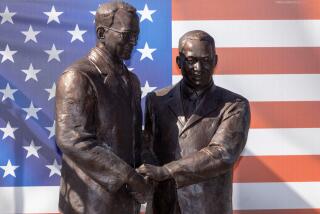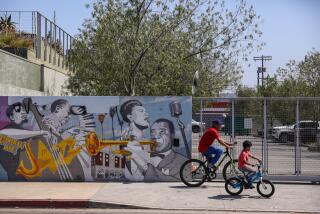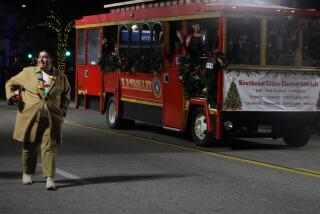Mayor Who Reshaped L.A. Dies
Tom Bradley left his mark on senators and governors, police chiefs and community activists, but the core of his legacy--and the source of his most impassioned tributes Tuesday--was the city work force that he remade over the course of a generation and the black middle-class he nurtured into prominence.
He led the effort to bring the Summer Olympics to Los Angeles, an event that crowned his peak years. And even his legacyâs great failures--the subway system he loved too much and the riots that shadowed his final year in office--were disappointments of the heart.
When Bradley became mayor in 1973, he inherited a hidebound, overwhelmingly white city government, one at whose hands he had suffered as a police officer and city councilman before winning the governmentâs top post. Minorities in those days held some jobs but not many, and most of them were relegated to the lower ranks of city government.
By the time Bradley left the job in 1993, he had built one of the worldâs most diverse work forces, one whose ranks were filled with officials deeply loyal to the sphinx-like mayor.
âHe was stoic in public but, in private, he was very warm and often humorous,â said former Deputy Mayor Tom Houston, who served as Bradleyâs chief of staff from 1984 to 1987. âEverybody on the staff had tremendous affection for him. He was a great human being.â
Maureen Kindel, whom Bradley appointed as the cityâs first female chief of the Public Works Commission, recalled her former boss emotionally, fighting tears as she described the effect he had on her life.
âEverything I have today I owe to him,â she said. âHe recognized a few small talents and gave me the opportunity to use them. I know there are probably hundreds of other people who can say that. He literally changed the face of the city. He gave a voice to women and minorities and others who had been invisible at City Hall.â
Todayâs Los Angeles government is nearly as diverse as the city itself. One in four city workers is Latino; one in five is black; nearly one in 10 is Asian. And whites, who occupied seven out of 10 municipal jobs when Bradley took office, now fill fewer than half.
Indelible Mark on City
Dozens of those city employees gathered Tuesday at a somber meeting of the Los Angeles City Council, many of whose members sought out Bradley for advice over the years. As the tributes piled up, some listened with tears in their eyes.
After a moment of silence in which City Hall palpably paused, Bradleyâs successor, Richard Riordan, spoke.
âThis is a very sad day for Los Angeles,â said Riordan. âBut also a very happy day as we talk about the memory of this great leader. He left a great legacy for all Angelenos from the Olympics to the skyline and diversity. Tom, we will miss you but we will remember you.â
Council President John Ferraro, who met Bradley when Bradley was a Los Angeles police sergeant and Ferraro was a police commissioner, said the former councilman and mayor left an indelible mark on the city.
âHe was a great individual, and we will miss him. But by the same token, letâs celebrate his accomplishments,â Ferraro told the solemn group assembled in the chamber.
Bradleyâs famous stoicism was often remarked upon Tuesday. But those who knew him best pointed out that it was deceiving--that beneath his placid exterior, Bradley was a canny politician who stood behind his allies and was willing to tangle with his adversaries.
In 1996, when one of Bradleyâs most important appointees, Police Chief Willie L. Williams, was under fire at the helm of an agency close to Bradleyâs heart, the former mayor and several close allies gathered in Hancock Park to coach Williams on how to fight for his job. Williams, the cityâs first African American police chief, waged that campaign unsuccessfully.
And on Tuesday, Williams was among those who lamented the passing of a friend and former boss.
âHe constantly insisted that the men and women of the department be respectful of the community. He supported community policing and insisted that the officers reflect the diversity of the city and county. People may or may not have always agreed with him, but he always spoke up for whatâs good for the people who lived and visited in our city.â
Although department leaders and elected officials may have seen him most, Bradleyâs presence was felt far beneath the upper strata of city government. Many of the cityâs rank-and-file employees saw him as their boss too.
âHe always treated everyone with class no matter what your station in life,â City Hall Police Officer Ron Curry said Tuesday. âHe could bring any group together--no matter how rich or how poor. He will be missed.â
Bradleyâs influence on Los Angeles reached beyond its municipal work force. He nurtured young talent and broadened the cityâs ruling class, once overwhelmingly white and Protestant, now dizzyingly diverse, over the decades.
Johnnie L. Cochran Jr., now an internationally known criminal defense lawyer, was a 17-year-old fraternity pledge when Bradley took him under his wing. âWhat a treasure of a man,â Cochran said Tuesday. âI loved him.â
Councilman Richard Alarcon once worked as an aide to Bradley. Councilwoman Jackie Goldberg walked precincts for Bradley in his first campaign for City Council. Councilman Mike Feuer was a volunteer in one of Bradleyâs unsuccessful runs for governor. Anthony Villaraigosa, the speaker of the California Assembly, said he thought of him as a mentor.
Phil Depoian met Bradley when he was a student volunteer in the presidential campaign of Robert F. Kennedy and Bradley was the county coordinator of that effort. Depoian went on to become Bradleyâs driver and now serves as deputy executive director of the cityâs Department of Airports.
âPeople bought into Tom Bradley,â Depoian said. âThey never strayed very far from this oak tree of a man. . . . He had a great love for this city and its people.â
As a coalition builder, Bradley had few peers. He came to office four years after Sam Yorty ran a vicious, race-baiting campaign that denied Bradley the post. Bradley took that in stride, never losing his composure and setting out to run again in four years.
That time, he won. It was 1973.
U.S. 9th Circuit Judge Steven Reinhardt was there that day. He recalled how Bradley, at the moment of his long-awaited victory, finally showed a crack in the armor of his stoic public persona. After the inauguration ceremony, he walked over to the Dorothy Chandler Pavilion, where his supporters awaited him at a reception. There, Bradley stood at the top of the stairs, raised his hand to the audience and declared: âI is de mayor.â
âIt was the most human, personal thing anyone had ever seen,â Reinhardt said. âUp until that moment he had been as solid as a wall. He had never talked like a black person. It was the first time he showed his emotion at being a black man and having gotten where he was.â
That election had such a galvanizing effect on Los Angeles that almost anyone who was here for it remembers it. After it, the city was never the same.
âAt the time you could walk through City Hall and see no black person who was not a janitor,â Reinhardt said. âThen suddenly you had a black mayor and it changed the whole nature of City Hall and the city. It sent such a message to young children, who had never thought of any black person being a mayor.â
Even Bradleyâs adversaries found him a hard man to dislike. County Supervisor Gloria Molina clashed with Bradley fiercely over the cityâs use of redevelopment money.
âBut no matter how strong and fierce the debate was, this is a man who was a gentleman, who could walk through all of it, have integrity, have leadership and be a very respectful person,â she said. âThatâs why itâs really tough to see somebody like that leaving us, because there are very few people like him.â
And retired Police Chief Ed Davis, whose conflicts with his former Police Academy classmate were legendary in local politics, recalled Bradley fondly.
âI had a great respect for Tom. He was on a different side of the world then I was, but he was a good leader on that side of the world,â said Davis, who graduated with Bradley from the academy Sept. 3, 1940. âHe was a responsible man. He comported himself in a statesmanlike fashion, and I was always proud to have one of my classmates as mayor.â
Turbulent Final Years
While Bradley sketched his place in the hearts and life of Los Angeles, he also encountered disappointments. He twice ran for governor, losing by a whisker in 1982 and then more solidly in 1986. His later years were dogged by questions about city contracts and investments, and though he was never prosecuted, the investigations took their toll on him.
Nearing the end of his tenure, events seemed to catch up with Bradley. By the time he left office, he had amassed his share of wreckage.
Bradley came to power in the wake of the 1965 Watts riots, and he left it with Rodney G. King and the 1992 riots fresh in the public mind. Those were dark days for Bradley, whose long-brittle relationship with Police Chief Daryl F. Gates left the men barely on speaking terms.
In the months after the King beating, Bradley tried to nudge Gates from office, but the chief clung to his job, and their mutual distrust steadily deepened. By the time a Ventura County jury returned not-guilty verdicts against the four officers charged in the King beating, Gates and Bradley had not spoken for more than a year.
That breakdown contributed to inadequate preparation for violence and to confusion in the early hours of the riots. It also made both men the objects of withering criticism.
âWhile [Bradley] was clearly more aware than Gates of the potential for violence in South-Central, the mayor shared the chiefâs view that the videotape of the Rodney King beating would produce convictions,â author Lou Cannon wrote in âOfficial Negligence,â his landmark history of modern Los Angeles. âBradleyâs judgment was further clouded by an attitude that he shared with many black leaders: He feared the LAPD more than he feared the prospect of mob violence.â
Dream of Rapid Transit
Meanwhile, Bradleyâs dream of a city crisscrossed by a modern subway system degenerated from mere boondoggle into a transportation mess.
That debacle had its roots in the 1973 campaign against Yorty, when Bradley promised voters he would quickly have a plan for a rapid transit system.
âHe was a little off on his timing,â recalled his friend, Rep. Julian Dixon (D-Los Angeles).
Still, Bradley was determined to see that the dream of a subway became reality. He forged a formidable coalition of business and labor to press for the funds to build it.
âWe would walk the halls together back here, lobbying to get his thing started,â Dixon said in an interview from his Capitol Hill office. âHe had a vision of a rapid transit system. He recognized that buses and cars werenât always going to be sufficient to move people around.â
County Supervisor Zev Yaroslavsky, who served as a City Council member through much of Bradleyâs mayoral term, also recalled Bradleyâs fervor for the project.
âHe saw the subway not just as a transportation project but as a jobs program,â Yaroslavsky said.
But problems steadily overtook the subway, as the transportation agency proved more adept at building debt than rail lines. Beneath his public support for the project, Bradley grew increasingly distressed about the cost overruns, construction problems and delays that were afflicting the subway project.
âHe was frustrated with the tempo of things . . . at not getting it done,â Dixon said. âHe was very disappointed from time to time in the leadership.â
One of Bradleyâs last-ditch attempts to put the subway back on track was his decision to bring Franklin White to Los Angeles to serve as the first chief executive of the Metropolitan Transportation Authority. After Bradley left office, the Riordan-dominated MTA board fired White over Bradleyâs objections.
Today, the subway system that Bradley envisioned exists as little more than a case study in mismanagement.
âHe truly wanted to see some rapid transit in Los Angeles,â longtime friend and county Supervisor Yvonne Brathwaite Burke said. âMany of those goals no longer seem plausible.â
In his final weeks, Bradley often appeared in public, despite a stroke that left him unable to speak more than a few words. He loved to dine with former staff members, who would regale him with tales about their careers. Bradley would laugh and nod.
âYou always felt he conveyed a lot just by his eyes and his body language,â said Wendy Greuel, a former Bradley aide who went on to Washington and is now an executive at DreamWorks SKG. âI still felt we could communicate.â
He attended movie premieres, went to tennis matches at UCLA and even took a cruise to Alaska. When the Democratic National Committee came to Los Angeles to scout sites for the 2000 convention, Bradley was there.
One dinner party in the Pacific Palisades six weeks ago featured a stream of loving tributes from former aides and friends. Bradley sat quietly through the accolades and then, emotionally, rose and tried to speak.
âThank you,â he said, beaming but struggling. âThank you. Thank you. Thank you.â
Times staff writers Jeffrey L. Rabin, Ann-Marie OâConnor, Jean Merl, Josh Meyer, James Rainey, Ted Rohrlich, Jill Leovy and Phil Willon contributed to this story.
* MIKE DOWNEY: The Olympics were a Bradley triumph. A3
* BILL BOYARSKY: Bradley emphasized deeds, not words. A14
* PATT MORRISON: Tom Bradley is what California is all about. B1
(BEGIN TEXT OF INFOBOX / INFOGRAPHIC)
Bradleyâs Legacy
From Los Angeles International Airport to Crenshaw to Little Tokyo, Tom Bradley has been honored and remembered in bronze, concrete and steel. Here are the Los Angeles landmarks that bear his name:
* Tom Bradley International Terminal, LAX
* Tom Bradley New Westminster Youth Center, Watts
* Tom Bradley Multipurpose Senior Center, South-Central
* Tom Bradley International Center, UCLA
* Tom Bradley Fountain, New Otani Hotel, Little Tokyo
* Tom Bradley/Civic Center Station, MTA Red Line subway
* Tom Bradley Wing, Los Angeles Central Library
* Tom Bradley Exhibit Hall, Convention Center
* Tom Bradley Reception Room, City Hall tower
* Tom Bradley Theater, Los Angeles Theatre Center downtown.
* Tom Bradley Auditorium, 20th Street Elementary School, South-Central
* Tom Bradley Football Stadium, Birmingham High School, Van Nuys
* Tom Bradley Bridge, pedestrian walkway at White Memorial Hospital, East Los Angeles
More to Read
Sign up for Essential California
The most important California stories and recommendations in your inbox every morning.
You may occasionally receive promotional content from the Los Angeles Times.











